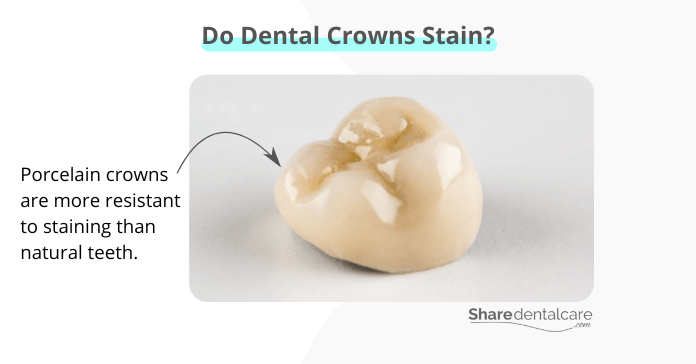Crowns are a popular dental restoration option that can improve the appearance and restore the function of damaged teeth. They can be used to restore teeth damaged by trauma or decay. However, many people are concerned about whether or not crowns stain. In this blog post, we will discuss the likelihood of crown staining and what you can do to prevent it from happening.
Do Dental Crowns Stain?
Generally, dental crowns are made of porcelain or ceramic, which makes them more resistant to staining than natural teeth. However, it is still possible for crowns to stain over time. Stains don’t penetrate the surface of porcelain or ceramic crowns unless they are damaged or cracked. In most cases, dental crowns stain can be removed with professional cleaning.
Temporary crowns, which are usually made of acrylic, are more prone to staining than porcelain crowns because the material used to make temporary crowns is not stain-resistant.
What Causes Crowns To Stain?
Crowns can stain due to the following:
- Dental crown damage: If the crown is cracked or chipped, it can allow substances to penetrate the surface and cause staining.
- Poor oral hygiene: Not brushing and flossing your teeth regularly can allow bacteria and plaque to build up on the crown, leading to staining.
- Certain foods and drinks: Consuming highly pigmented foods, beverages, and substances (like tea, coffee, and dark-colored sauces) can leave stains on your crowns.
- Tobacco: Smoking and using other forms of tobacco can cause tar and nicotine to build up on the surface of crowns.

Are Crowns Stain Permanent?
The good news is that, in most cases, dental crown stains are not permanent. Most surface staining can be removed with professional cleaning. If the staining is deeper and more significant, you may need to have your crowns re-glazed or replaced.
If the crowns have been severely damaged or cracked, stains may be more difficult to remove and crown replacement may be necessary.
You can read more about how to repair a chipped crown with exposed metal.
Why Dental Crowns Appear Darker After Teeth Whiting?
Sometimes, crowns may appear darker after teeth whitening. This usually happens because the natural teeth color is lightened during the whitening process, while the crowns remain the same shade. This color difference can make crowns appear darker than before.
You can read more about teeth whitening for crowns and veneers.
How To Protect Your Crowns From Damage & Staining?
To protect crowns from staining and damage, it is important to practice good oral hygiene habits. Brush and floss your teeth twice a day, be mindful of the foods that you are consuming (especially those with high levels of acidity or pigment), and avoid smoking or using other forms of tobacco. Additionally, regular dental check-ups are important to ensure that your crowns are in good condition and to catch any potential issues early.
Do Crowns Stain – Conclusion
Dental crowns are durable and stain-resistant, but they can still be prone to staining over time. The most common causes of crown staining are crown damage, smoking, poor oral hygiene, and certain foods and drinks. Fortunately, most surface staining can be removed with professional cleaning. However, if the crown is damaged or cracked, stains may be more difficult to remove and crown replacement may be necessary.